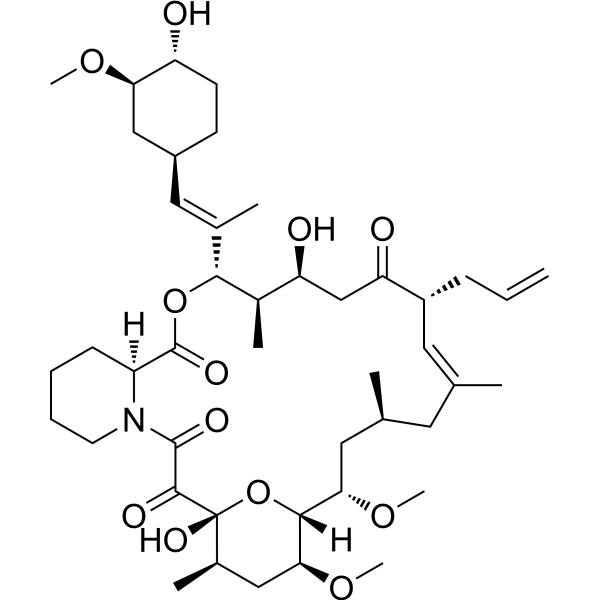| Synonyms: |
Tacrolimus;(2-propenyl)-,(3s-(3r*(e(1s*,3s*,4s*)),4s*,5r*,8s*,9e,12r*,14r*,15s*,16r*,18s*;16-dimethoxy-4,10,12,18-tetramethyl-8-3-(2-(4-hydroxy-3-methoxycyclohexyl)-1;19-epoxy-3h-pyrido(2,1-c)(1,4)oxaazacyclotricosine-1,7,20,21(4h,23h)-tetrone,5,6,8,11,12,13,14,15,16,17,18,19,24,25,26,26a-hexadecahydro-5,19-dihydroxy-3-(2-(4-hydroxy-3-methoxycyclohexyl)-14,16-dim;6,8,11,12,13,14,15,16,17,18,19,24,25,26,26a-hexadecahydro-5,19-dihydroxy-5;fr900506;prograf;tsukubaenolide;FK-506;C44H69NO12;FK 506;FK-506 (Tacrolimus);FK506(Tacrolimus);Tacrolimus (FK-506 , FR-900506, Fujimycin,Prograf®,Protopic®,Advagraf®);Tacrolimus solution;Tarcolimus; Fujimycin;Tacrolimus (FK506);ferric oxide;Tacrolimus Impurity;Protopic;FK506;Tacrolimus anhydrous;Modigraf;Protopy;LCP-Tacro;Anhydrous Tacrolimus;Advagraf;8-DEETHYL-8-[BUT-3-ENYL]-ASCOMYCIN;K506;Astagraf XL;Prograf (TN);Tacarolimus;FR 900506;Y5L2157C4J;FK5;Tacrolimus (anhydrous);Prograft;Tacrolimus [USAN];Graceptor;Envarsus;Avagraf;L 679934;Envarsu;17-allyl-1,14-dihydroxy-12-[2'-(4'-hydroxy-3'-methoxycyclohexyl)-1'-methylvinyl]-23,25-dimethoxy-13,19,21,27-tetramethyl-11,28-dioxa-4-azatricyclo[22.3.1.04,9 ]octacos-18-ene-2,3,10,16-tetraone;17-allyl-1,14-di-hydroxy-12-[2-(4-hydroxy-3-methoxy-cyclohexyl)-1-methyl-vinyl]-23,25-dimethoxy-13,19,21,27-tetramethyl-11,28-dioxa-4-aza-tricyclo[22.3.1.04,9] octacos-18-ene-2,3,10,16-tetraone;17-allyl-1,14-dihydroxy-12-[2'-(4'-hydroxy-3'-methoxycyclohexyl)-1'-methylvinyl]-23,25-dimethoxy-13,19,21,-27-tetramethyl-11,28-dioxa-4-azatricyclo[22.3.1.04,9 ]octacos-18-ene-2,3,10,16-tetraone;QJJXYPPXXYFBGM-UHFFFAOYSA-N;MFCD00869853;17-allyl-1,14-dihydroxy-12-[2'-(4'-hydroxy-3'-methoxy -cyclohexyl)-1'-methylvinyl]-23,25-dimethoxy-13,19,21,27-tetramethyl-11,28-dioxa-4-azatricyclo-[22.3.1.04,9 ]octacos-18-ene-2,3,10,16-tetraone;1,14-dihydroxy-12-[1-(4-hydroxy-3-methoxycyclohexyl)prop-1-en-2-yl]-23,25-dimethoxy-13,19,21,27-tetramethyl-17-prop-2-enyl-11,28-dioxa-4-azatricyclo[22.3.1.04,9]octacos-18-ene-2,3,10,16-tetrone;144490-63-1;SY069910;17-Allyl-1,14-di-hydroxy-12-[2-(4-hydroxy-3-methoxy-cyclohexyl)-1-methyl-vinyl]-23,25-dimethoxy-13,19,21,27-tetramethyl-11,28-dioxa-4-aza-tricyclo[22.3.1.04,9]octacos-18-ene-2,3,10,16-tetraone;17-allyl-1,14-dihydroxy-12-[2'-(4'-hydroxy-3'-methoxycyclohexyl)-1'-methylvinyl]23,25-dimethoxy-13,19,21,27-tetramethyl-11,28-dioxa-4-azatricyclo[22.3.1.04,9 ]-octacos-18-ene-2,3,10,16-tetraone;FT-0626431;104987-11-3;17-allyl- 1,14-dihydroxy-12-[2'-(4'-hydroxy-3'-methoxycyclohexyl)1-methylvinyl]-23,25-dimethoxy-13,19,21,27-tetramethyl-11,28-dioxa-4-azatricyclo[22.3.1.04,9 ]octacos-18-ene-2,3,10,16-tetraone;NS00008708;HMS503O21;CAS-104987-11-3;NSC 758659;TACROLIMUS (USP-RS);(3S,4R,5S,8R,9E,12S,14S,15R,16S,18R,19R,26aS)-5,19-dihydroxy-3-{(1E)-1-[(1R,3R,4R)-4-hydroxy-3-methoxycyclohexyl]prop-1-en-2-yl}-14,16-dimethoxy-4,10,12,18-tetramethyl-8-(prop-2... |






















